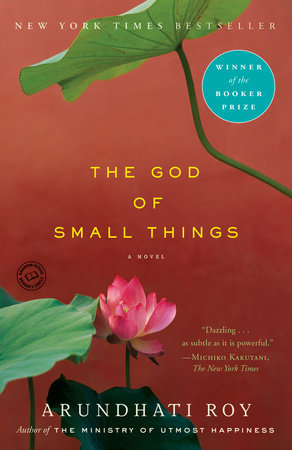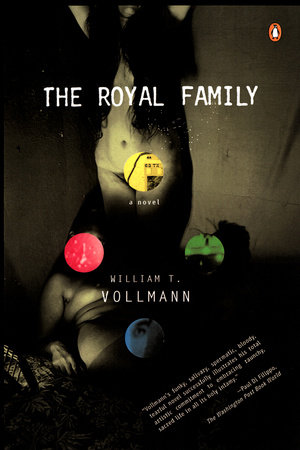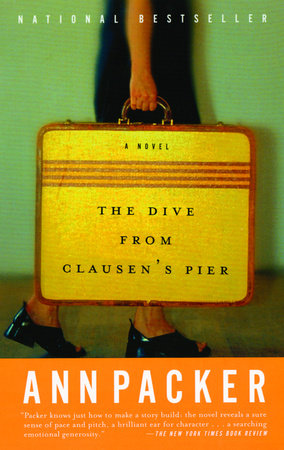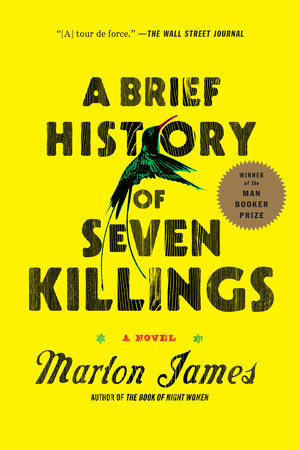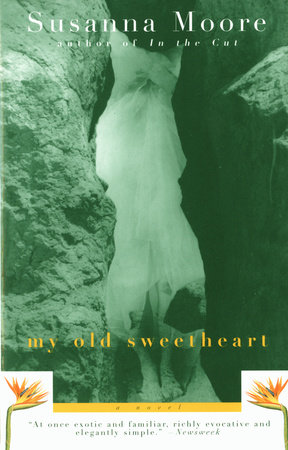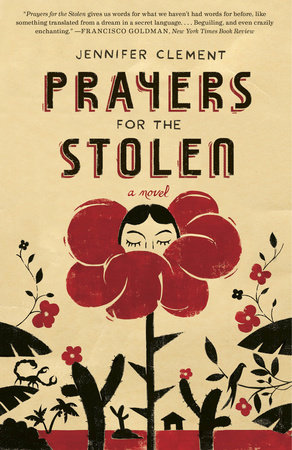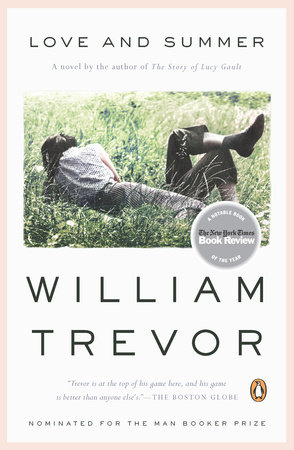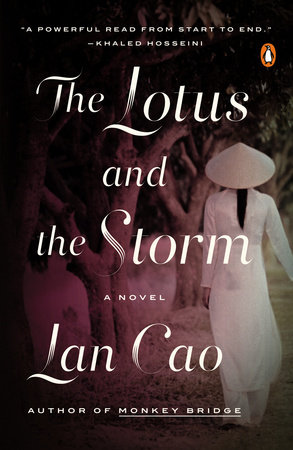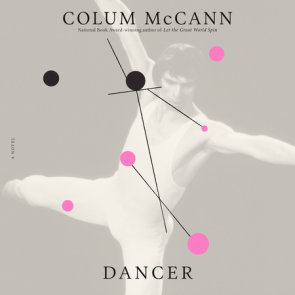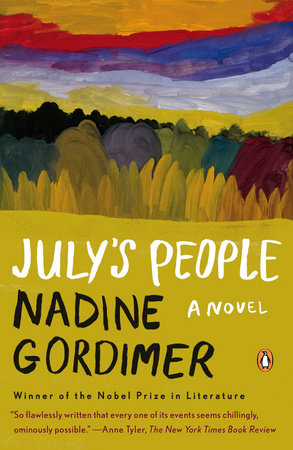Author Q&A
A conversation with Colum McCann and Nathan Englander
Nathan Englander was born in New York in 1970. His short fiction has appeared in The Atlantic, The New Yorker, and numerous anthologies including The Best American Short Stories, The O. Henry Prize Stories, and The Pushcart Prize. Englander’s story collection, For the Relief of Unbearable Urges, earned him a PEN/Malamud Award and the American Academy of Arts and Letters Sue Kaufman Prize. He was a Guggenheim Fellow in 2003 and a Fellow at the Dorothy and Lewis B. Cullman Center for Scholars and Writers at the New York Public Library in 2004. His first novel, The Ministry of Special Cases, was published in 2007. He lives in New York City.
Nathan Englander: I think everyone likes to go off calling his or her latest book a big departure. But as a reader of yours, as someone who gets a little private access to your brainpan, I really think Let the Great World Spin is a departure for you. How do you feel about that?
Colum McCann: I suppose the great dream of this writing lark is that the books continuously get newer and deeper and stronger. Or at least we hope that we’re not repeating ourselves. Vonnegut said that we have to be continually jumping off cliffs and developing our wings on the way down. I think that’s what happened with this book. I saw a big cliff and I took off. Inevitably I will smash to the ground. That’s what happens with every book. At this moment, though, I’m still flying, still catching the updrafts, still trying to understand it.
NE: There’s no way to talk about the Twin Towers without recalling the tragedy of their destruction. Did you see this as a 9/11 book when you started? Do you see it as one now?
CM: I remember you and I talking about this book while walking through Central Park together in 2004—how I couldn’t shake the dust of 9/11 off me, how I had to clear it from the air around me. I was finishing Zoli at the time, but really I was looking toward this book. At first it was a “eureka” moment because I was wondering how it might be possible to talk about the events of that terrible September, and all the Septembers that followed, and I said, “Ah yeah, that’s it. I should go backwards. Wherever we are now is wherever we once were.”
But as the years went on, the image of Petit became increasingly iconic and consequently less original. There was a film, a book, a New Yorker cover. Still, I couldn’t back away from the image. I wanted to reanimate it and give it a different meaning. And eventually I used the tightrope walk only as a way to pull the reader through the novel. In fact, the tightrope walker doesn’t matter at all in the end of the story. The story comes right down to the ground, in the very dark of night, in the roughest part of New York, when two little girls emerge from a Bronx housing complex and get rescued by strangers. That, for me, is the core image of the novel. That’s the moment when the towers get built back up. So yes, I wanted to shake 9/11 out of my body by going all the way back to a different point of innocence. I wanted to know how I felt about war, and art, and liberation theology, and issues of technology, all these things that were on our minds back in ’74 and are on our minds today also.
NE: The way the past is woven into the present—not just lined up with it but braided in.
CM: Yes, exactly. It’s important to say that this is my own emotional response to 9/11, it’s not a measured intellectual response.
It’s my stab at a personal healing. I’m not here to preach. I just lay out a landscape so that people can walk into it, or walk out, hopefully with their souls shifted sideways an instant. I’m not interested in telling people what to think, but I do hope that I’m allowing them a new space in which to breathe. And so—in this respect—it doesn’t have to be a 9/11 novel at all. It could also be just a book about New York in 1974 and how we are all intimately connected.
NE: It’s a humble position, and I think it’s the right one, to boot. Authorial intent doesn’t much matter once the book is out there. If I write a funny, happy story, and all it ever does is make people cry—well then it’s a sad story, whether I agree or not. What the reader sees on the page is what’s there.
CM: That’s exactly it. As writers we have to respect and like our readers. I want to acknowledge that they’ve taken a chance and that, more than likely, they’re smarter than me, or more courageous, or at the very least they will continue the book further than I can. They can complete the story. And really the ending of this particular book says: There is no end. There is grief and there is love and they spin together in this human body, which is, in itself, also a book.
NE: You talk about souls shifting sideways in people. The souls of books shift along the way as well. Did you envision the whole plot of this book in advance? How do you even map out such a thing?
CM: I just get happily lost over and over again! It’s a fairly intricate maze, but I never mapped it out, it just kept unfolding for me. Part of the joy of writing, as you know, is that we cast the boat out from the shore without any clue when, or if, we’re going to be able to hit land. This novel terrified me in the sense that there were times I didn’t feel like I was writing it at all. I was being blown around by twelve different voices.
NE: Corrigan is such an interesting, troubled, sincerely hopeless character. The one thing that’s clear to me is that he truly believes, and he feels that’s maybe enough to inspire—just putting that belief in the world. Does that make sense to you?
CM: Absolutely. He believes because it’s there and it’s real, it’s in front of his eyes. Funnily enough, I miss that man. I’m so sorry he died. There are times I want to roll back the stone and apologize to him. I kept trying to resurrect him but he refused my advances. Isn’t it strange, that we can create characters from dust and then they become more real than the person we met at the party last night? I think about Kaddish from Ministry of Special Cases that way. He is flesh-and-blood real to me, a brilliant character. I am still climbing over the graveyard wall with him.
NE: You’re a nice man. Thanks for that. My question, then, is about the challenges you set for a character, whether it’s the length of a tightrope or the height of a wall.
CM: The higher the better, right?
NE: Maybe so. But how high is the one Corrigan has to climb?
CM: You know, with Corrigan I wanted him not just to walk the wall but to follow the loops of the razor wire, to find himself circling the barbs. I have wanted for a long time to write about faith and belonging, especially in a radical Catholic context. I wanted a man who would look at the world in all its filth and poverty and yet still believe that, one day, the meek might actually want it. And Corrigan was the one who liberated me in this book. He was the one who brought me back to Dublin, then zipped me back over to New York, and then introduced me to all the other characters in the book. It was as if he led me by the hand and said, “I want you to meet this woman, Tillie. . . .”
NE: I mentioned the way Corrigan holds on to his belief. I think your Tillie has some of that too. There’s a kind of hope in her. A person who’s given up doesn’t threaten to give God a drubbing if she doesn’t find her Jazzlyn waiting in heaven. To me, Tillie still believes in something.
CM: She has to believe. Otherwise it’s completely hopeless. Even in suicide there’s a belief that she will see her daughter once more. It’s strange but as I grow older, I find myself developing more optimism. I keep inching toward the point where I believe that it’s more difficult to have hope than it is to embrace cynicism. In the deep dark end, there’s no point unless we have at least a modicum of hope. We trawl our way through the darkness hoping to find a pinpoint of light. But isn’t it remarkable that the cynics of this world—the politicians, the corporations, the squinty-eyed critics—seem to think that they have a claim on intelligence? They seem to think that it’s cooler, more intellectually engaging, to be miserable, that there’s some sort of moral heft in cynicism. But I think a good novel can be a doorstop to despair. I also think the real bravery comes with those who are prepared to go through that door and look at the world in all its grime and torment, and still find something of value, no matter how small. I like those authors like yourself, like Aleksandar Hemon, like John Wray, like Chimamanda Ngozi Adichie, who have the courage of their convictions. There is a light to their work, an open door.
NE: Let’s talk about this alleged ‘light,’ Mr. McCann, and where it comes from. If I understand the rules, light needs a source. Would it be fair to say that everything starts to brighten up for you once you begin your research? And when I say research, what I really mean is when you go off and live, as best you can, what you’re writing about. I know we’re focused on Let the Great World Spin, but how about you over-answer for me and share a bit about sandhogs and subway tunnels and your time with the Romani people?
CM: I don’t mean for this to sound trite, but I really like life. I enjoy my time here. I always quote Mandelstam on this score: “But we must love this poor earth, for we have not seen another.” And I love engaging with life on the ground. I have a theory that a lot of the light rises up from beneath us: We have to keep moving in order for it to surround us. But I like the dark places also. I want to dwell for a while in the more anonymous corners and see what happens there.
So often I go out and live my books a little. I don’t want to write about myself. If I wrote exclusively about myself it would be a book about me sitting on my arse in a New York apartment, a middle-class white man with a wonderful wife and three fabulous children. But as Montaigne says: “Happiness writes white.” It doesn’t hit the page. So we have to search elsewhere. And so for me the logical conclusion is that I have to write outside my life. Every time I write a book I feel like I go to university. I take a brand-new three-year crash course in that which I want to know. For This Side of Brightness I went down into the subway tunnels and hung out with the homeless people. I also chatted with the sandhogs who built the tunnels. For Dancer I went to Russia, hung out in hospitals and dancehalls and Stalin-era apartments. For Zoli I went to Slovakia and over the course of two months wandered my way around the Gypsy camps. Of course I can’t write when I travel like this. But I’m preparing myself to write. I like getting in semi-dangerous situations. I’m not anywhere near as brave as someone like William T. Vollmann, or Dave Eggers, but I like getting close to the edge. There’s a raw electricity to it. And then I can live out my demons in fiction and come home, spend time with my kids, be ordinary, precisely because the rest of my day has been extraordinary.
And for Let the Great World Spin, I did a fair amount of research—I went out in New York with homicide detectives, chatted with folks in the Bronx, dug through piles of rap sheets, spent time with computer hackers, that sort of thing. One thing I want to say is that I had a lot of fun writing this book. It wrenched a lot out of me emotionally, but I enjoyed the process, and wrote it relatively quickly.
NE: This is not your first New York novel—how was writing about the recent past different than reaching back a century?
CM: No different at all. The thing that matters most to me are the words on the page, how they meet, how they touch. Of course a time or a landscape will define the type of language you use, but I’m pretty comfortable roaming around in different hats.
NE: Let the Great World Spin paints a broad picture of New York. Do you want to talk about the various worlds you walk us through?
CM: I wanted it to be a Whitmanesque song of the city, with everything in there—high and low, rich and poor, black, white, and Hispanic. Hungry, exhausted, filthy, vivacious, everything this lovely city is. I wanted to catch some of that music and slap it down on the page so that even those who have never been to New York can be temporarily transported there.
NE: The idea of the world spinning reaches way beyond the title. It’s central to this book, and I think it’s central to some of your other novels as well—Songdogs, This Side of Brightness, even Dancer, really. They’re all about people moving, crossing borders, people who end up as citizens of the world, if that’s not too syrupy a way to say it—or maybe you see them as displaced?
CM: I’m interested in what Ondaatje calls the “international mongrels of the world,” or what Rushdie calls the “international bastards,” all those people with no place and yet every place inside them. The best line I ever heard along these lines was from John Berger. I met him in Paris. We were both a little over-served, shall we say, wine and vodka, and I asked him where he was from. He looked at me strangely, as we are friends and we’d been corresponding a long time, and he said, “England, of course.” And I said in the most ridiculous way, “I know, I know, I know, but where are you from from?” He smiled that big smile of his, those eyes of his. He waited a long time and then he said that he was “a citizen—no, no, not a citizen—a patriot of elsewhere.”
NE: “A patriot of elsewhere.” It doesn’t get much better than that. And New York can feel like a sort of elsewhere sometimes. I was just in Nigeria, and when people asked me what country I was from, I kept slipping and saying, “New York.” It turns into its own floating territory when I’m far away. One of the points of this novel is that, no matter how many worlds New York contains within it, it’s really a wonderful, singular, unified city. You show that on page one of the book—we all look up at the sky together. But you also do it later, weaving all the grieving mothers together at Claire’s house, all those mothers and all those lives.
CM: Nine million stories taking place at any one time. Imagine the music.
NE: A lot of it Irish.
CM: Jewish too. The immigrant experience. All of us are sort of lost and looking for a way to go back home. So we go back home in books, stories.
NE: Did you meet Philippe Petit? Has he discussed the book with you?
CM: No—not yet anyway. We talked on the phone and we chatted about the book, and I sent it to him, but we haven’t met, and I don’t know how he feels about it. I hope he likes it, but I didn’t write it to please him. We each walk different tightropes. I love what he did. I think he’s an artist. I spun out from his walk, in the same way that the title spins out from Tennyson, which in turn spins out from a series of sixth-century Arabic poems. Everything has a precedent.
NE: You and I are both Matteo Pericoli fans. Do you want to talk about the American hardback cover he drew for your book?
CM: Loved it. Love his work. He stretched the city out. It’s interesting to me how different countries have completely different covers. In England it was a guy bent over backwards, in a sort of wry ironic way. In France it was a figure high in the sky. In Germany it was a constructionist cover, a man rolling upon a globe. It says so much about how different we are, how vast and spinning this globe is. But Matteo Pericoli’s work is especially beautiful in my opinion, and I will always cherish that first edition.
NE: Am I allowed to ask what’s next?
CM: You’re allowed to ask, but only if I ask you first.
NE:Me? I’m retired. No, no, I’m working hard. There are a couple of things hopefully headed out into the world. Right now I’m busy digging into a new novel. It’s set in Israel, unless, of course, it ends up in Detroit or Spokane. You never know what a book will demand. And you, my friend, what’s the plan?
CM: Well, I’m recovering, actually. This one knocked the stuffing out of me. And so I’m reading and sketching and watching and waiting. I’m circling around the notion of going home, and by that I mean Ireland, but Ireland is an everywhere now, so who knows? I am also interested in the difficulty of writing about peace, so maybe Ireland, maybe Israel, we’ll see. That’s part of the joy. Having no idea where I’ll spend the next three, four years.



